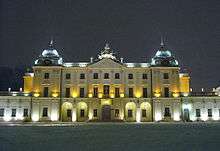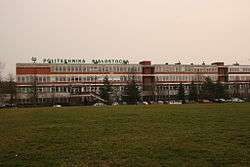History of Białystok
The city of Białystok has existed for over five centuries, during which time the fate of the city has passed between various political and economic forces.
- This is a sub-article to Białystok

From surviving documentation we know that around 1437, a representative of the family Raczków, Jakub Tabutowicz with the coat of arms of Łabędź, received from Michael Žygimantaitis son of Sigismund Kęstutaitis, Duke of Lithuania, a wilderness area located along the river Biała that marked the beginning of Białystok as a settlement.[1][2] Białystok administratively was part of the Podlaskie Voivodeship, after 1569 also part of the Lesser Poland Province of the Crown of the Kingdom of Poland.
During the years 1617–1626, the first brick church and a beautiful castle, on a rectangular plan with two floors, in the Gothic-Renaissance style, was built by Job Bretfus. Extension of the castle continued by Krzysztof Wiesiołowski, since 1635 Grand Marshal of Lithuania and the owner of several administrative and royal and married Aleksandra Marianna Sobieska. In 1637 he died childless, thus Bialystok came under the management of his widow. After her death in 1645 the Wiesiołowskis estate, including Białystok, passed to the Commonwealth, to maintain Tykocin Castle. In the years 1645–1659 Bialystok was managed by governors of Tykocin.[3][4]
In 1661 it was given to Stefan Czarniecki as a reward for his service in the victory over the Swedes. Four years later, as a dowry of his daughter Aleksandra who married Jan Klemens Branicki, thus passing into the hands of the Branicki family.[5][6] In 1692 Stefan Mikołaj Branicki, the son of Jan Klemens Branicki (Marshal of the Crown Court), obtained the rights to the city of Białystok from King John III Sobieski and built Branicki Palace in the city on the foundations of former defensive castle of Wiesiołowskis' family.[7] In the second half of the 18th century the ownership of the city was inherited by Field Crown Hetman Jan Klemens Branicki.[1] It was he who transformed the previously existing palace built by his father into the magnificent residence of a great noble.[8][9]
At the end of the 19th century, the majority of the city's population was Jewish. According to Russian census of 1897, out of the total population of 66,000, Jews constituted 41,900 (so around 63%).[10] This heritage can be viewed on the Jewish Heritage Trail in Bialystok.[11]
From the very beginning, the Nazis pursued a ruthless policy of pillage and removal of the non-German population during World War II. The 56,000 Jewish residents of the town were confined in a ghetto.[12] On 15 August 1943, the Białystok Ghetto Uprising began, and several hundred Polish Jews and members of the Anti-Fascist Military Organisation (Polish: Antyfaszystowska Organizacja Bojowa) started an armed struggle against the German troops who were carrying out the planned liquidation of the ghetto.[13][14]
Capital of administrative divisions
Over the course of the last 200 years, the city has been the capital of numerous administrative divisions of a number of countries or occupying powers;
- Capital of the New East Prussia province, Kingdom of Prussia from 1795 to 1807 [15]
- Capital of the Belostok Oblast, Russian Empire from 1807 to 1842 [16]
- Capital of the Belostok Province of the Grodno Governorate, Russian Empire from 1842 to 1915 [17]
- Capital of the Bialystok-Grodno District of the German-controlled territory of Ober-Ost during World War I (1915–1918) [18][19]
- Capital of the Białystok Voivodeship, Second Polish Republic from 1919 to 1939 [20]
- During World War II it was the capital of the Belastok Voblast, Byelorussian SSR from 1939 to 1941 and 1944 to 1945 [21][22]
- Capital of Bezirk Białystok during the World War II occupation of Poland by Nazi Germany from 1941 to 1944 [23][24]
- Capital of the Białystok Voivodeship, People's Republic of Poland from 1945 to 1999[25][26]
Białystok was, from 1945 until 1975, the capital city of the Białystok Voivodeship.[27] After the 1975 administrative reorganization of the People's Republic of Poland, the city was the capital of the smaller Białystok Voivodeship which lasted until 1998.[28]
Since 1999 it has been the capital of the Podlaskie Voivodeship, Republic of Poland.[28]
Prehistory and protohistory
Archaeological discoveries show that the first people settled on the territory of the present Bialystok already in the Stone Age. Tombs of ancient settlers found in the district Pieczurki, Dojlidy and in some other parts of the city.[29]
In the early Iron Age a mix of Prussians, Yotvingians and population Wielbark culture, after which the remaining kurgan – probably the tombs of the chiefs in the area in the village Rostołty.[30]
Since then, the Białystok area has been at the crossroads of cultures. Trade routes linking the Baltic to the Black Sea favored the development of settlements with Yotvingia-Ruthenian-Polish cultural characteristics.[30]
Middle Ages
From surviving documentation we know that around 1437, a representative of the family Raczków, Jakub Tabutowicz with the coat of arms of Łabędź, received from Michael Žygimantaitis son of Sigismund Kęstutaitis, Duke of Lithuania, wilderness areas located along the river called the Biała River.[31]
Jakub Raczków divided the land between his four sons: Nicholas, John, Wenceslas and Jundziłła. Nicholas inherited the estate in 1462 in Bialystok and erected a mansion near the current location of the Branicki Palace. After the year 1479 Bialystok took good son Nicholas, Nicholas is also known as Bachelor, because he studied at Cracow Academy. He was secretary to King Alexander Jagiello and a member of the Privy Council.
Early Modern era
Wiesiołowski Estate (1514–1661)
It is precisely for these times comes the first written reference (1514), listing the good of Bialystok. Bachelor's son Nicholas, Nicholas Bakałarzewicz, realized in 1524, his wife Catherine Wołłowiczówna, Bogorya coat of arms. After his death in 1547, according to the good will of the deceased Catherine has inherited. In the same year his widow, Catherine Wołłowiczówna, married again to Peter Wiesiołowski (Ogończyk coat of arms) – a courtier of the Polish kings: King Sigismund the Old and Sigismund Augustus. He started in Bialystok on the borderlands of Lithuania and Polish residence. After his death in 1556, took a good Bialystok sons: Peter and John Wiesiołowski. However, after the death of the latter in 1570 became the property of Bialystok Peter Wiesiołowski (the Younger). In 1579 he married Zofią Lubomirską.
In his time began the development of Bialystok. In 1581, the parish church next to the existing Peter Wiesiołowski funded school for children. In addition, built in the years 1617–1626, the first brick church and the beautiful castle on a rectangular plan, two floors, the Gothic-Renaissance style built by Job Bretfus. Extension office continued by his son Krzysztof Wiesiołowski, since 1635 Grand Marshal of Lithuania and the owner of several administrative and royal and married Aleksandra Marianna Sobieska.[32] In 1637 he died childless, thus Bialystok came under the management of his widow. After her death in 1645 the Wiesiołowskis estate, including Białystok, passed to the Commonwealth, to maintain the castle in Tykocin. In the years 1645–1659 Bialystok managed by governors of Tykocin.[33] It was then a part of the Grand Duchy of Lithuania.
Branicki Estate (1661–1802)
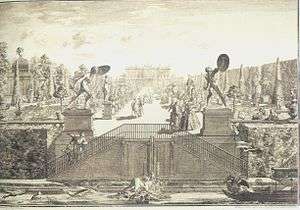
In 1661 it was given to Stefan Czarniecki as a reward for his service in the victory over the Swedes.[34][35] Four years later, as a dowry of his daughter Aleksandra who married Jan Klemens Branicki, thus passing into the hands of the Branicki family.
In 1692 Stefan Mikołaj Branicki, the son of Jan Klemens Branicki, obtained the rights to the city of Białystok from King John III Sobieski and built Branicki Palace in the city on the foundations of former defensive castle of Wiesiołowskis' family.[36] The project's author is a prominent architect: Tylman of Gameren.[36] In the second half of the 18th century the ownership of the city was inherited by Field Crown Hetman Jan Klemens Branicki. It was he who transformed the previously existing palace built by his father into the magnificent residence of a great noble,[37][9] which was frequently visited by Polish kings and poets.[38] Numerous artists and scientists came to Białystok to take advantage of Branicki's patronage. In 1745 Branicki established Poland's first military college, School of Civil and Military Engineering and in 1748, one of the oldest theaters in Poland, the Komedialnia.[39] New schools were established, including a ballet school in connection with the foundation of the theater.[40] On 19 November 1748 marries Izabella Poniatowska as his third wife Hetman Jan Klemens Branicki. Białystok received its city charter on 1 February 1749 from King Augustus III of Poland.
- 1753 the center of the city burns down
- 1756 Jan Klemens Branicki is divorced from his third wife
- 13 July 1769 – Battle of Białystok part of the War of the Bar Confederation
- 9 October 1771 – Jan Klemens Branicki dies,
- 1789 – the epidemic of smallpox, the 22 children died
- third partition of the Polish-Lithuanian Commonwealth in 1795 it first belonged to the Kingdom of Prussia as the administrative seat of the Białystok Department
- 26 January 1796 – Prussian administration takes over the town, but it remains formally owned by Izabella Poniatowska-Branicka
Modern Era
New East Prussia Province (1795–1807)
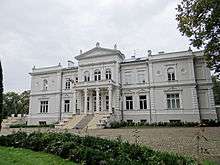
- 1 March 1802 – the signing of an agreement between Izabella Poniatowska-Branicka and Nowowshodnią Prussian and the War – Economic Camera. Prussians agreed to the rule of law in
- 2 April 1802 – Izabella Poniatowska-Branicka sells Bialystok to the Prussian authorities for an amount over 270 thousand talarów
Belostok Oblast (1807–1842)
During the period of Russian control the city was the capital of the Belostok Oblast, from 1807–1842. After the Peace of Tilsit were signed in 1807 the city passed to Russia.
- 14 February 1808 – Izabella Poniatowska-Branicka dies
- 3 July 1812 – Napoleon's army enters the city,
- 13 July 1812 – Declaration of the inhabitants of communication with the Commonwealth,
- 4 August 1812 – Russian army enters the city
- 8 August 1812 – giving a new coat of the city by Tsar Alexander I
- 13 December 1830 – announcement of martial law by the Russian authorities in connection with the outbreak of the November Uprising,
- 1 February 1831 – setting up headquarters in the Russian army commander, Field Marshal Hans Karl von Diebitsch, whose task was to suppress the November Uprising
- 1834 – a ban on teaching in schools in the Polish language
Belostok Province (1842–1914)
During the period of Russian control the city was the capital of the Belostok Oblast, from 1807–1842, afterward it was a provincial capital within the Grodno Governorate.
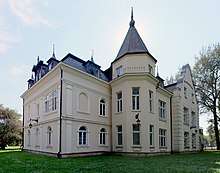
- 15 December 1859 – was born Ludwik Zamenhof – the creator of the international language Esperanto,
- 13 June 1860 – the beginning of a patriotic demonstration under the banner of national unity and fight against colonization,
- 9 June 1861 – arrive in the city representative of the Whites, Andrzej Artur Zamoyski
- 1862 – Opening of the Saint Petersburg–Warsaw Railway through the city
- 24 April 1863 – the beginning of the January Uprising in the Bialystok area
- 1877 – expanding the city limits: integrated railway station, the village of Piaski and Las Zwierzyniecki
- 1886 – the railway line Bialystok – Vawkavysk – Baranovichi
- 1891 – Launch of the first telephone exchange
- 1895 – launch of three lines of horse tram
- 1898 – establishment of the Volunteer Fire Department
During the 19th century the city became a major center of textile industry. Due to an industrial boom the population grew from 13,787 in 1857, and 56,629 in 1889, to 65,781 in 1901.
At the end of the 19th century, as a result of the influx due to Russian discriminatory regulations, the majority of the city's population was Jewish. According to Russian census of 1897, out of the total population of 66,000, Jews constituted 41,900 (so around 63%).[41]
Early 20th Century
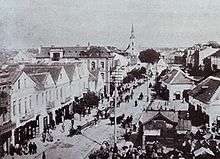
The first Anarchist groups to attract a significant following of Russian workers or peasants, were the Anarcho-Communist Chernoe-Znamia groups, founded in Białystok in 1903.[42][43] Their ranks included mostly students, factory workers and artisans, though there were also peasants, unemployed laborers, drifters, and self-professed Nietzschean supermen.[43] They drew their support mainly from the impoverished and persecuted working-class Jews of the "Pale"-the places on the Western borders of the Russian Empire where Jews were "allowed" to live.[44]
During the 1905 Russian Revolution the city was a center of the radical labor movement, with strong organizations of the General Jewish Labour Bund and the Polish Socialist Party as well as the more radical anarchists of the Chernoe-Znamia (Black Banner) association.
The Białystok pogrom occurred between 14–16 June 1906 in the city. During the pogrom between 81 and 88 people were killed by the Russians, and about 80 people were wounded.[45][46][47]
World War I (1914–1918)
After the outbreak of the First World War in 1914, the first heavy bombing of the town took place on 20 April 1915. On 13 August 1915 German soldiers appeared in Białystok. The city was included in the Ober Ost occupational region as the capital of the Bialystok-Grodno District.[18][48] On 18 March 1918 it was declared part of the Belarusian National Republic[49] until 19 February 1919 when the city was taken by Poland.[50]
Polish Independence
On 11 November 1918, following the end of World War I, Marshal Józef Piłsudski, declared the establishment of the Second Polish Republic. Bialystok and the region around it was kind of a buffer zone between the newly established Polish state and Soviet Russia. However, after Germany's defeat, over half a million German soldiers remained in Russia. On 11 November 1918, following the end of World War I, Marshal Józef Piłsudski, declared the establishment of the Second Polish Republic. At the same time, the German garrison in Bialystok, officers formed a soldiers' council (Soldatenrat). In 1917, the Central National Committee existed in the city, Bialystok District, at the head of which they stood priest Stanisław Nawrocki, pastor from Zabłudów and pharmacist Feliks Filipowicz. On the night of 11 November 1918, the Central National Committee concluded a peace agreement with Soldiers' Council. The Germans pledged to hand over their weapons and warehouses, while the Poles guaranteed them a safe departure to Eastern Prussia. Some of the Polish troops that found themselves in Łapy went to Białystok, where they were to support the Self-Defense Guards that had been created earlier, being a formation organized by officers from the corps of general Józef Dowbor Muśnicki, students who, under the command of Tuśkiewicz, formed a force of 50 people and took over the posts at the station and in front of major buildings in the city.
German authorities tried to isolate the population of the occupied areas such as Białystok from the newly established Polish state. Temporary eastern border reborn and Poland was to be insured by the Lithuanian-Belarusian Division of general Wacław Iwaszkiewicz and the Podlasie Division of general Antoni Lisowski organized in Biała Podlaska. From December 1918, the Polish government commissioner Ignacy Mrozowski resided in Białystok. He accepted it created in time German occupation Temporary City Committee (consisting of 16 local citizens, including 6 Poles), headed by Józef Puchalski. However, the situation was difficult and troublesome. The Germans took away the entire archive, leaving the municipal cash register empty. In addition, the organizational structure of the German military authorities deepened and demoralized groups of soldiers roamed the city.
A General Civil Commissioner was then appointed to the Military Board of the Eastern Borderlands, which was to be the highest civil instance in the discussed territories - ruling and executive. In the field, commissioners were assigned to individual armies as inspectors of the General Civilian Commissioner poviat commissioners were to administer the poviat. Maciej Jamontt became the district commissioner for the areas of Białystok, his competences extended to poviats: Białystok, Bielsk, Sokółka, Grodno and Wołkowysk. Augusta Cyfrowicz was appointed as commissioner of the Białystok Poviat, his deputy was Bolesław Szymański, and the government commissioner of Bialystok, Napoleon Cydzik (he was to cooperate with the Provisional Municipal Committee, as well as prepare and conduct in the first municipal elections).[51]
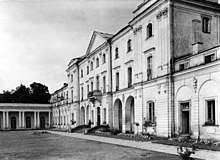
The German command wanted to keep the railway lines at all costs, so that this army could return to Germany, and there were only two roads: through Białystok and Grajewo to East Prussia or through Warsaw to Berlin. Józef Piłsudski chose to avoid the option of German Army passing through the center of the country and be withdrawn by road through Białystok. Therefore, Białystok had to be left in German hands. On 5 February 1919, another Polish-German agreement was signed, so that where the German army withdrew, Polish troops could enter, because of the Russian Revolution and they were afraid of the occupation of other cities by the Red Army.[52] Following that, a Provisional Municipal Committee was created, headed by Józef Puchalski, an experienced local government official and patriot. Representatives representing the Polish, Jewish, German and Russian communities sat on the committee. On 8 February 1919, the Committee met again. A German commander of Bialystok, Roszer, sat next to Puchalski, and gave a farewell speech. Over the next days, the Germans liquidated their administration.[53]
The retreating German Army set in fire the barracks in Osowiec Fortress as well as in Tragutta Street in Białystok. On 16 February 1919, Polish troops entered Bielsk Podlaski, the next day Polish military authorities arrived in Białystok welcomed by Ignacy Mrozowski. Colonel Stanisław Dziewulski was nominated for the first commandant of Bialystok.[54] Finally, On 19 February 1919, Polish troops entered Białystok. According to with earlier arrangements, Germans were to leave Białystok at 2:00AM. There was a two-hour delay and the army left the city at 4:00 AM. Some branches waited for more trains at the station. Citizens arrived to the city center, expecting the soldiers. The weather was rainy, there was also anxiety as for will they come for sure. Around 9 p.m. the first uhlans entered the town from the side of Lipowa Street, the infantry entered from Kilińskiego Street. As it turned out, they were only patrols. The main troops entered Bialystok a little later.
.jpg)
All were led to the Lubczyński confectionery, where a meal was organized. In the morning, infantry entered the city of Białystok under the command of Stefan Pasławski who a few years later he was the governor of Białystok. Uhlans appeared, commanded by Colonel Stanisław Dziewulski. An official ceremony was prepared for Thursday and Friday takeover of Białystok from German hands. The official transfer of power and main celebrations took place on Saturday, 22 February 1919:[55] On the day of welcoming Polish troops, it was freezing rain, which made horses slide on the pavement. The soldiers successfully reached the Market Square. The official welcome of the Polish army began with a field mass celebrated by Father Lucjan Chalecki. The altar was set in front of the gate of the Old Church. After its completion interim president Józef Puchalski welcomed everyone and passed on symbolic bread and salt to colonel Stanisław Dziewulski. Then Captain Delhaes spoke on behalf of the German garrison, who gave power to the Poles. The ceremony on the market ended with a festive parade. In the evening, the audience watched the theater "Revenge" of Alexander Fredro. The show was prepared by team of the Torch Society, led by Zygmunt Różycki. After the performance, Rena Ruszczewska (at the time 18 years old) recited a poem specially prepared for the ceremony. The city became part of the reborn Poland as the capital of Białystok Region.
Polish- Soviet War
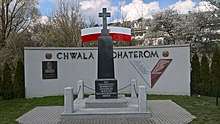
In 1920, when overrun by Soviet forces during the Polish-Soviet War, it briefly served as headquarters of the Polish Revolutionary Committee headed by Julian Marchlewski, which attempted to declare the Polish Soviet Socialist Republic.[56][57] The city again changed hands after the Battle of Białystok. The Peace of Riga, signed 18 March 1921, formally included the city in the Second Polish Republic.
Inter-war period
In the years 1919–1939, the city was part of the Second Polish Republic as the seat of the Białystok Voivodeship. The city, whose population reached 107,000 in 1939, was the Voivodeship's lone industrial center.
After the wars and the reestablishment of independent Poland, Polish education in Białystok was restored and the textile industry was revived.[38] A municipal public library was established, sports clubs were founded, including Jagiellonia Białystok, and in the 1930s a dramatic theater was built.[38] A rare silent 16mm color Kodachrome film of the Jewish Quarter of the city by Dr. Benjamin Gasul gives an insight into everyday life in July 1939.[58]
On 7 September 1919, the first election to the city council (Polish: Rada Miejska) was held. By expressing their opposition to including suburbs in the city limits, the Jews did not vote. The turnout was only 12%. The election was won by the Polish Election Committee (Polish: Polski Komitet Wyborczy), which received 35 seats out of 42. As President of the city was elected Bolesław Szymański and Feliks Filipowicz became the president of the city council.[53]
Education
On 7th of November 1919 in accordance with governmental decree on compulsory education, a free primary school for children aged 7-14. Until 1922, the number of primary schools in Bialystok rose to 14 (from 5 in 1919), private and religious education was also organized. Gradually, language learning was introduced. In the first period after completion there were two junior high schools (on Warszawska Street and Kościelna Street), over time, a third (on Mickiewicza street) and four Jewish ones were opened. On 23rd of May, 1920 the City Public Library was opened at 1 Kilińskiego, had 3,500 book volumes and 40 magazine titles.[59]
Healthcare
For reconstruction and the reorganization of the health service, Dr. Zygmunt Brodowicz came to the city on behalf of the Minister of Health and from 1927 Brodowicz became the Head of the Labor Department and Social Welfare, then the Health Department in the Białystok Voivoedship Office, was the main organizer and coordinator of the construction of a psychiatric hospital in 56 Choroszczanska Street. As a result of his activity, the Infectious Hospital was moved to Wojskowa Street, where it became the property of the city as the City Hospital.[60]
Economy
From the second half of 1919, industry in Białystok began to work for the needs of the Polish Army and administration. Growing sales in the internal market has stabilized the economic situation, although the city was still in the vicinity of the front, and the Polish-Bolshevik war and thus there were organizational difficulties: transport restrictions, numerous stationing troops, robberies, etc. The end of hostilities, so awaited, paradoxically complicated the industrial situation of the city. Along with the end of military operations, military orders ended following the sealed the border with the USSR, which resulted in a drastic reduction in sales for manufactured goods.[61] Entrepreneurs were forced to look for new recipients (China, Japan, the Baltic States and the Balkans), but here too there were problems: high duties, inflation, significant increase in raw material prices and production costs. The problems with the sales markets resulted in the period lasting until 1931 (excluding the period of relatively good economic situation for 1926-1928) stagnation in the textile industry.[62]
Infrastructure and urban layout
In the interwar period, massive investments were carried out to liquidate backwardness of the city caused by the periods of the First World War and tsarist occupation policy. They joined the road construction (about 100 km of road surfaces were commissioned in the period in question), 25km of sidewalks were laid, further residential houses were erected (around 1935 there were over 5,000 of them, 70% of which were connected to the municipal water supply system), works on the regulation of the Biała River and the extension of the sewage network. An urban plan was developed for the systematic development of the city in and was approved in 1938.[63] it was assumed among others location of industrial centers in Fasty, Starosielce and Dojlidy, delineation of transit roads on the east-west and north-south axes, and a brick housing estate was constructed on the site of the poor Jewish district of Chanajki. On Mickiewicza Street, modern buildings such as the Tax Chamber and the District Court were built in 1933, and Aleksander Węgierki Dramatic Theatre was completed in 1938. green areas were regulated, and parks were marked out such as Planty [64]Park. Throughout the interwar period it was located in at the corner of today's Kilińskiego and Pałacowa Streets, the neo-Baroque "Ritz" Hotel, which played the role trade and market town hall (with a guard observation tower located on the tower).[65]
Jewish community
The Torah education system in Białystok during the 1930s was unique in that the Cheder and the Mesivta Yeshiva were both in the same city and under the same educational system. Most other cities only had a cheder.[66]
World War II (1939–1944)
At the turn of March and April, preparations for protecting the population against the effects of bombing and gas attacks were intensified in Bialystok. The population was adapted for individual self-defense, training was provided, and trenches and shelters were planned. Specialized services were created: alarm, communications, fire, rescue-sanitary and technical. In addition to scouts, representatives of: the Air and Gas Defense League (LOPP), the Polish Red Cross, the Western Union, Military Adoption, the Union of Reservists and Riflemen, and other organizations were involved in these activities. "Echo Białostockie" instructed what to do in the event of an air alarm. At the end of July, a large-scale operation of digging anti-aircraft ditches in the city began. Most of them were to be located downtown, in the area of two railway stations and barracks. Local citizens participated in rebounds for the purchase of armaments for the army. For example, employees of the Plywood State Factory from Dojlid, employing over 400 people, bought a heavy machine gun for the Polish Armed Forces. Also, money was collected for the National Defense Fund (Polish: Fundusz Obrony Narodowej) and Maritime Defense Fund (Polish: Fundusz Obrony Morskiej). On the eve of the outbread of the war, growing espionage and subversion activities took place, which strained the relations with the local Germans, and from May 13 it was banned to hold public gatherings among German population.
On the first of September 1939 the German invasion of Poland began. German bomber squadrons flew over the areas of the then Białystok Voivodeship, the first bombs fell in the area of Białystok railway station and military barracks. The local press reported on the successes of the Polish Forces and the raids of Polish Air Force on Berlin. Only the information about the entry into East Prussia of cavalry squadrons supported by horse artillery proved to be true. On the first defensive line there was relatively calm, there were only fights around Myszyniec and Grajewo. According to the Polish defense plans, Białystok was not intended for defense, and the military units located in the city took positions far from their garrison. However, the news coming from Narew led to the decision to resist:[67] Lieutenant Colonel Zygmunt Szafranowski (commander of the District Command of Supplements and at the same time the oldest rank officer in Bialystok) and Captain Tadeusz Kosiński decided to fight using the marching and spare units as well as groups of soldiers retreating from Narew. They had at their disposal primarily the marching battalion of the 42nd Regiment and the incomplete guard battalion No. 33. Other sub-units were added, Infantry arrived from near Wizna were gathered as well as two squadrons of the 2nd Grochow Uhlan Regiment from Suwałki. The units created defensive line along Dojlidy and Nowe Miasto, through Wysoki Stoczek, to Pietraszi: Uhlans from two squadrons of the 2nd Regiment were placed Białostoczek and Pietrasze, guard battalion No. 32 was deployed in Nowe Miasto, and the center of defense was the hills of Wysokie Stoczek manned by the marching battalion of the 42nd infantry regiment commanded by Lieutenant Ignacy Stachowiak. In addition, the city's defenders were supported by a company of heavy machine guns and one artillery platoon. In total, the order of battle numbered around 900 soldiers.[68]
Combat contact with German troops was established on September 13 near Żółtki, and on September 15 in the morning the Germans stormed the central section of Polish positions in the Marczuk and Wysoki Stoczek districts. The opponent's advantage was devastating. K. Kosiński died and buried in St. Roch's cemetery. After several hours of persistent defense and repulsion of four German attacks, first two squadrons of the 2nd Grochów Regiment, then the 42nd Regiment companies retreated towards the city, and after a short rest left in the evening further east towards Wołkowysk (following the war it was transferred to Byelorussian SSR).[69]
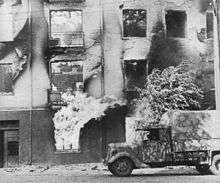
On 15 September, Białystok was occupied by the "Lötzen" Fortress Brigade under the command of General Otto-Ernst Ottenbacher.[70] Two days later, on 17th of September Soviet troops joined them. Between 20 and 22 of September discussions were held at the Branicki Palace regarding the transfer of the city from German to Soviet hands. According to the agreement, the Wehrmacht was to leave the city until 22 of September by 14:00. At the conclusion of the negotiations, the delegations went to a dinner in Ritz Hotel. And so, On 22 of September a ceremony of handing over the city was held at the courtyard of the Branicki Palace with the participation of Ivan Boldin who was the commander of the Cavalry-Mechanized Group in the Belarusian Military District and Andrey Yeremenko who was the commander of the 6th Cavalry Corps. The Germans handed over power to the Soviets and withdrew.[71] The city passed to the Soviet Union with respect to the secret protocol of the Molotov-Ribbentrop pact,[72]
NKVD set up its office in Bialystok, which occupied the building of the District Court in 5 Mieczkiewica Street.[73][74] Among the victims of the arrests wave were employees of the District Court who were arrested such as Józef Ostruszka, the last president of the court (he was imprisoned in Bialystok, then expelled with others to Soviet camps), Vice President Karol Wolisz, Jan Bolesław Stokowski who chief secretary of the regional court and head of the Tax office. The People's Assembly of Białystok met on 28–30 October in Białystok under the slogan: "death to the white eagle".[75]
On 22 October 1939, less than two weeks after the invasion, the Soviet occupation administration organized elections into a National assembly of West Belarus (Belarusian: Народны сход Заходняй Беларусі). The official turnout was 96.7 percent, and 90 percent of the vote was given to candidates backed by the Soviet Union. The Elections to the People's Assemblies of Western Ukraine and Western Belarus took place under control of NKVD and the Communist Party. On 30 October the National Assembly session held in Belastok passed the decision of West Belarus joining the USSR and its unification with the Belarusian Soviet Socialist Republic. These petitions were officially accepted by the Supreme Soviet of the USSR on 2 November and by the Supreme Soviet of the BSSR on 12 November.[76] The Belastok Voblast with the center in Belastok was created in 1939.
Following the incorporation of Bialystok and the surroundings as Belastok Region in the Belarusian SSR, a policy of Sovietization began. In 1940 the town hall and the city scales' building were demolished to provide a large space for holding rallies and demonstrations. The square was decorated with eye-catching, red posters. At Sovietskaya Street (Rynek Kosciuszki) 27 the Gorky District Library replaced the City Public Library. Semyon Igayev was appointed to the secretary of Bialystok's Obkom, a former Second Secretary of Mogilev Obkom. The NKVD established its headquarters at Mickiewicza Street at the now Voivodeship Office. The first head of the provincial NKVD was Alexander Misiuriev who was later replaced by Peter Gladkov and Sergei Bielchenko. The gorkom (city council) was located at 21 Warszawska Street, in a non-existing building. Grisha Gershman was appointed to the first secretary of the City Committee.
After entering the Soviet Union, thousands of ethnic Poles, Belarusians and Jews, were forcibly deported to Siberia by the NKVD, which resulted in over 100,000 people deported to eastern parts of the USSR.[77] Among the deported Poles were civil servants, judges, police officers, professional army officers, factory owners, landlords, political activists, leaders of cultural, educational and religious organizations, and other activists in the community. All of them were dubbed enemies of the people.[78]
The inclusion of Białystok in the BSSR, apart from the large influx of people from the USSR, created the conditions for the migration of people from the surrounding towns, including many local Belarussians to the city, probably mainly to improve the ethnic base for exercising power in the city. The process of institutionalization of Belarussians and Belarusian culture took place in the city on a larger scale: Among others Belarusian schools, pedagogical institute with the Belarusian language faculty and Belarusian theater were set up in the city. During this period there was a change in ethnic stratification in the city. Poles lost their dominant significance.[79]
Polish resistance against the Soviets in the area of Bialystok (especially along the swampy Biebrza river) began immediately after the September Campaign and in mid-1940 there were conspiratorial organizations in 161 towns and villages in the future area of Bezirk Bialystok.[80] Skirmishes with the NKVD were common, mostly around Jedwabne, where the anti-Soviet feelings were the strongest.
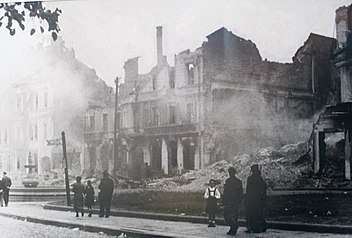
In the aftermath of the June 1941 Battle of Białystok–Minsk, part of the German attack on the Soviet Union, Białystok was placed under German Civilian Occupation (Zivilverwaltungsgebiet) as Bezirk Bialystok. The area was under German rule from 1941 to 1944/45, without ever formally being incorporated into the German Reich.
It has been established that at the beginning on 22 June 1941 the withdrawing Soviet troops, that were forced out by the German army, committed regular crimes against the inhabitants of Białystok and its area.[81] Civilians who happened to be in the vicinity of the passing Soviet troops were shot dead. There were cases of the whole families being dragged out of their houses and executed by firing squads in Białystok and the areas surrounding.[81]

On the morning of 27 June 1941, troops from Police Battalion 309 of the Order Police[82] surrounded the town square by the Great Synagogue, the largest wooden synagogue in Eastern Europe, and forced residents from their homes into the street. Some were shoved up against building walls and shot dead. Others– some 800 men, women and children– were locked in the synagogue, which was subsequently set on fire; there they were burned to death. The Nazi onslaught continued with the demolition of numerous homes and further shootings. As the flames from the synagogue spread and merged with the grenade fires, the entire square was engulfed. Some 3,000 Jews lost their lives that day (27 June 1941), out of an estimated population of 50,000 Jews living in the city at that time.[83]
As the years went by, German terror in Bezirk Bialystok worsened and most atrocities on civilian population were committed by German units and police from neighboring East Prussia.[84] During the German occupation, a mass murder of Poles in the Bacieczkowski Forest (today lying on the border of Starosielce, Leśna Dolina and Bacieczki districts) was carried out by the Germans. In 1943, the German occupiers shot several hundred representatives of the Białystok intelligentsia: Germans placed men, women and children in ditches and shot them with automatic weapons. In July and August 1943 several hundred doctors, lawyers, priests, teachers, officials, students and pupils were killed. This crime deprived Białystok of much of its pre-war intelligentsia. A monoument was erected in the site in 1980.[85]
In July 1943 the Uderzeniowe Bataliony Kadrowe (UBK) units, active in Bezirk Bialystok, consisted of five Battalions. Altogether, there were 200 fighters, and during a number of skirmishes with the Germans (including the Raid on Mittenheide in 1943), 138 of them were killed. These heavy losses were criticized by the headquarters of the Home Army, who claimed that the UBK was profusely using lives of young Polish soldiers. On 17 August 1943, upon the order of General Tadeusz Bor-Komorowski, the UBK was included into the Home Army. Soon afterwards, all battalions were transferred to the area of Nowogrodek.
From the very beginning, the Nazis pursued a ruthless policy of pillage and removal of the non-German population. The 56,000 Jewish residents of the town were confined in a ghetto, which during August 1943 was removed.
In the last year of the occupation, a clandestine upper Commercial School came into existence. The pupils of the school also took part in the underground resistance movement. As a result, some of them were jailed, some killed and others deported to Nazi concentration camps.
A number of anti-fascist groups came into existence in Białystok during the first weeks of the occupation. In the following years, there developed a well-organized resistance movement.
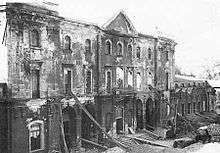
On 15 August 1943, the Białystok Ghetto Uprising began, and several hundred Polish Jews and members of the Anti-Fascist Military Organisation (Polish: Antyfaszystowska Organizacja Bojowa) started an armed struggle against the German troops who were carrying out the planned liquidation of the ghetto.
In the summer of 1944 heavy Soviet Forces pushed into the region as part of the Belostok Offensive: The 3rd Army managed to reach the outskirts of Białystok and even though encountered strong resistance from the LV Corps, stormed and took control of the city by 27 July after several days of street fighting.[86] While the Wehrmacht were retreating from the Soviet Armed Forces troops approaching Bialystok, its soldiers began the systematic destruction of the city with almost all the tenements and houses in the downtown, the Branicki Palace, the Teachers' Seminary buildings, all the most important local and state buildings, industrial and production facilities, a new viaduct built just before the war were set on fire on Dąbrowskiego street, barracks of the 42nd Infantry Regiment and the 10th Lithuanian Uhlan Regiment in Wygoda district, Ritz Hotel, hospital buildings and a power plant.[87]
Early post war years and re-joining Poland (1944–1948)
Germans began to systematically destroy the city center. First of all, it began with the main streets, three-story tenement houses, usually owned by the population Jewish. The streets: Lipowa, Sienkiewicza, Kupiecka, Zamenhoffa, Równoległa and others were burning. The last troops destroying the city withdrew 26 July in the afternoon, when the Soviet army was already visible on the outskirts of Bialystok. The destruction of the city was completed by two-day (25 and 26 July) artillery fire.
People's Commissariat for State Security (NKGB) took the building at the corner of Sobieski and Złota Streets. City administration headquarters had not beed chosen yet but on 27 July at 15:00 representatives of the Home Army and local government reported to the Garisson Komandant at Mickiewicza 35.[88] Also Sobiennikov himself, when he met Wojewoda J. Przybyszewski declared that he has no right to organize and local administration as according to the vote held on October 1939 the city became part of the Belarusian SSR.[89]
The party activists and partisans who carried out the orders of the Central Committee of the Communist Party of Byelorussia did not know on the preliminary border agreement concluded on 25 July, according to which Stalin confirmed to the representatives of the Polish Committee of National Liberation his decision to transfer Poland to Białystok and Łomża. It was based on these decisions that on 27 July in the afternoon a delegation of the Polish National Liberation Committee arrived at the Białystok-Krywlany Airport to take over the city from Soviet hands. The delegation included: Edwarda Orłowska, who had appoint the Polish Workers' Party apparatus, Colonel Tadeusz Paszta, responsible for organizing the Office of Security and Civic Militia, and Zygmunt Zieliński with a team of 12 soldiers, appoint and fill Ministry of Defense powiat headquarters. The day after, they were joined by Major Leonard Borkowicz and Capt. Jerzy Sztachelski who were representatives of the Polish Committee of National Liberation in the Białystok Province.
In the first days of August, Soviet activists were ordered to leave the lands which became part of 'Lublin Poland'. After arriving in Grodno they recreated however, the Białystok Regional Executive Committee (Polish: Białostocki obwodowy komitet wykonawczy). The final decision about its liquidation occurred in December 1944.[90]
Political situation
From 28 July, every day, Soviet soldiers also ran raids in the city to recruit men to work filling the pits at the bombed airport and building fortifications on the outskirts of the city. In August, the first militia units helped them. In addition, after the end of the work, forced meetings took place, at which the new authorities indoctrinated, vigorously criticizing the Polish Government in exile and the Home Army.
On 30 July 1944, PKWN activists posted appeals in the city informing that PKWN activists are the only legal authority in the city. The Polish government-in-exile represented by Józef Przybyszewski and the president of Bialystok Ryszard Gołębiowski, who revealed themselves to the Soviets as representatives of the legal Polish authorities and offered cooperation. On 3 August, militiamen and Kościuszko soldiers on the order of the Polish Committee of National Liberation made the first attempt to close the City Council appointed by the Government Delegate. On 7 August NKVD arrested at the next meeting of the Government Delegate and subsequently president of Bialystok, Ryszard Gołębiowski. NKVD in consultation with PKWN activists proceeded to the final hearing with the Polish underground state and its legal representatives. From the prison on Kopernicus Street from the summer of 1944 to the end of 1945 deported nearly 5,000 to the Soviet Union. underground soldiers. In 1944–1955, military courts in the Bialystok region sentenced over 550 people to death, of whom about 320 were murdered.[91] At the first meeting of the Municipal National Council (Polish: Miejska Rada Narodowa) in Bialystok on August 31, 1944, by an election resolution of the council as chairman the council was elected Witold Wenclik, and vice-chairmen Józef Jankowski and Jan Pietkiewicz. On May 30, Andrzej Krzewniak was appointed to that position (Przewodniczący MRN) and served until 1948.[92]
Economic policy
Alongside with political consolidation, the economic situation in the city was harsh, with shortages in most basic products. On 31 August 1944 the Municipal National Council ordered not tom issue food stamps to city residents (aged 17 to 55) who do not appear at the behest of the authorities to work on rebuilding the city. At the next meeting of the Municipal National Council, on 12 October 1944, it was decided that only employees would receive food stamps. Their family members were to remain without food allowances. Also, heavy taxation on all spheres of life: By resolution of the City Council, public games, entertainment events, and signboards were taxed and posters. A hotel tax was introduced, the land tax was increased by half, additional taxes were introduced for the production and sale of alcohol products. The consumption tax was introduced in mass catering establishments by key: from 7.00 to 19.00 -10% on the bill amount, from 19.00 to 21.00 – 20%, from 21.00 to the morning – 50%. Market fees and fees for the use of electricity and water were increased.
Culture and media
The authorities began working on return to normalization and the process saw the rapid launch of the Polish radio in the city and the opening, despite enormous housing and financial problems, of the Municipal Theater and the Library. To run megaphone city information, an old Soviet production amplifier donated by one of the Soviet commanders and surviving fragments of an overhead telephone line running from Warszawska Street towards Kościuszki Square and Mickiewicza street. The beginning of the network was a line specially made for the needs of the Gestapo, which Soviet soldiers did not steal. Lack of wires was supplemented, large Soviet megaphone loudspeakers (so-called gromkogoworitel) were mounted on lighting poles. They were located on the corner of Sienkiewicza and Warszawska, Pałacowa and Warszawska Streets (not far from the ruins of the Branicki Palace), Swiętjanski and Mickiewicza, and at Kościuszi Square. The whole base of the first radio was located in the building at Warszawska 13 St. Of course, it wasn't then we were talking about broadcasting any radio programs, because Polish Radio as such practically nonexistent. Megaphones were used for propaganda and information purposes.
After the securing of the city, during the Belostock Offensive of Operation Bagration, by the Soviet army on 27 July 1944, it was administered by the Byelorussian SSR as the capital of the restored Belastok Voblast. With the Border Agreement between Poland and the USSR of 16 August 1945, Białystok, with the surrounding area, was passed on to the People's Republic of Poland.
Polish People's Republic
Białystok was, from 1945 until 1975, the capital city of the Białystok Voivodeship. After the 1975 administrative reorganization of the People's Republic of Poland, the city was the capital of the smaller Białystok Voivodeship which lasted until 1998.
After the incorporation to the People's Republic of Poland, the formation of Białystok downtown (both restoration and redevelopment) took place under the influence of the architectural school of Tadeusz Tołwiński, whose student Ignacy Felicjan Tłoczek together with Stefan Zieliński were the authors of the general city plan of Bialystok which was approved in 1948. The works were preceded by a conference organized by the Ministry of Reconstruction and the Voivodeship of Białystok. The work lasted between May and December 1948. Another important general plan was drawn on behalf of the Spatial Regional Planning Directorate (Polish: Regionalna Dyrekcja Planowania Przestrzennego) by architects Stanisław Bukowski, Leszek Dąbrowski, Ignacy Tłoczek and Stefan Zieliński.
The plans assumed that by 1979 the city will have around 200,000 residents. The development direction was directed towards Supraśl definitely against previous trends in the development of the eastern part of the city. Establishment of a river port, sewage collector and main communication route, which was to be the basis for using the potential of the river valley. In the Jurowiec area, a river port with a nuisance industry center was planned based on the railway line leading there to Ełk. This center was to constitute the northwestern edge of the urban area. The Biała river valley was adopted as the basis for the directional development of the city (starting from Dojlid and ending at its mouth). The southern and western barriers to the city's development were to be forest areas, the airport in Krywlany and the swampy areas of Dojlidy. It was anticipated that in the west the city should not go beyond Słoboda (today's Nowe Miasto) and Starosielce-Bażantarnia to the north-east.
The districts were divided into functional zones: Administrative and cultural center located on the baroque axis of Branicki Palace and the two streets perpendicular to it: Warszawska and Piwna (Skłodowska-Curei). A shopping and offices center located between Lipowa and Sienkiewicza streets. Industrial center in Antoniuk and Fabryczna Station and Nowem and residential districts located in Antoniuk, Bojary on the right side of the Biala river and Piaski on the left bank of the Biala River. Recreation areas in the form of a forest in Pieczurki and Białostoczek, green areas along the Biała River.
The city center was according to the plan the main communication axis (current Piłsudskiego Avenue and Branickiego Street) and an administrative center – stretching from the historical center with the Kościuszki Square and ending with a complex of administrative buildings located at the intersection of the palace axis with Piwna Street (nowadays Skłodowska-Curie Street).
An important component of the reconstruction of the city center envisaged the moving of the core of the new city center away from the traditional town square to the 1989 Square. The House of the Party was constructed at the square with the Marie Curie Avenue which would act as "representative" avenue, stretching to the south from the square and will contain important public buildings. Kalinowskiego and Liniarskiego streets were created as well to connect the square to Lipowa Street. An important element in the planning of the city center after the war was the creation of "Parade Avenue", a representative thoroughfare. The shape was defined by Stanislaw Bukowski in 1950. As part of this plan, Marii-Curie-Skladowska Street (then called Alej Pochodow "Parade Avenue"). The street was designed to be constitute a new, representative axis of a socialist city. Along the street a number of important representative public buildings were built, such as the building number 1 (District Court), number 3 (House of the Unions Polish: Dom Związkowca), number 23 (The Actor's House), Polish: Dom Aktora)
Originally in place of the Central Department Store it was planned to construct the seat for the Presidium of the Voivodeship National Council.[93] Also, different plans called for a set of administrative buildings with the Voivodeship and the City Council at the head, as well as the central post office and cinema (called also Centrum II), at the intersection of Skladowska-Curie, Waszyngtona and Legionow streets. However, this part of the plan was never materialized.[94]
On 20 October 1956, people of Białystok gathered at the radios and listened to the speech of Władysław Gomułka delivered at the 8th Plenum of the Central Committee of the PZPR. A declaration of loyalty was published in Gazeta Białostocka from 23 October which emphasized the population of the Białystok region together with the entire Polish nation strongly supports the new leadership of the party in the implementation of the program outlined on the VIII Plenum. The next day around 15,000 people gathered in the courtyard of the [[Branicki Palace[[ (Medical University). First, the speeches of local PUWP leaders were heard, and then through the radio of Władysław Gomułka's speech Speaking representatives of the workplace strongly criticized the provincial state and party authorities. The first secretary of the communist party in the city, Jan Jabłoński even submitted a public resignation, which was later rejected by the Executive Committee of the PZPR. After the rally, some of the participants went home, but several thousand people mainly students and young workers walked through Lipowa Street towards the Church of St. Rocha. The demonstrators carried national flags as well as the Hungarian flag as a sign of support for the Hungarian uprising. When they reached the church of St. Rocha Father Adam Abramowicz asked for a peaceful departure.[95]
The October 1956 uprising which occurred in Poznan had influence on the Political situation in the country and led to the departure of the local party secretary, Jan Jabłoński, who resigned, again, on 31 October, and this time his resignation was accepted by the provincial authorities. Antoni Laskowski, a local party activist who was not imposed by the Central Committee for the first time, was entrusted with the function of the First Secretary of the Polish United Workers' Party, though this not for long, as after 3 weeks he was ousted by Gomulka. His place was taken by Arkadiusz Łaszewicz.
Throughout the 50s and 60s the fast growth of the city and its reconstruction from the damages of the war continued. The construction of the viaduct at Dąbrowskiego Street began, and the next year the W-Z route called Aleja 1 Maja (in 1990 it was renamed as Józef Piłsudskiego Avenue). In 1959 the Housing Cooperative 'Rodzina Kolejowa' was completed. Also, The number of inhabitants of Białystok increased, which in the late 1950s became demographically one of the most dynamically developing Polish cities. In 1956, this number exceeded 100,000 people. The main reason for such rapid demographic development was the migration from smaller towns and villages of the region.[95]
From the end of the 50s Bialystok saw massive construction of housing estates. Rodzina Kolejowa was inaugurated in 1959 and the 60s saw the construction of the Tysiąclecie housing estate. Between 1960 and 1965 mass housing estate was built in Antoniuk District. Late 60s and early 70s saw the construction of Przyjaźń, and Białostoczek housing estates as well as Dziesięciny I and II. The 80s saw the construction of Słoneczny Stok, Zielone Wzgórza and Nowe Miasto housing estates.[96]
In 1968, a branch of the University of Warsaw was established (in 1997 it received independence and named University of Białystok), as well as the Museum of the Polish Armed Forces. In 1973, construction of the amphitheater and the "Centrum" Department Store began. In 1974, the Puppetry Department of the State Higher School of Theater named after Aleksander Zelwerowicz opened, as well as a branch of the State Higher School of Music named after Chopin in Warsaw. The Symphony Orchestra received the status of a philharmonic, and a year later a new seat.[97]
Martial law
The network of Solidarity branches of the key factories of Poland was created on 14 April 1981 in Gdańsk. It was made of representatives of seventeen factories; each stood for the most important factory of every voivodeship of the pre-1975 Poland. The workers from the Białystok Voivodeship were represented by the Cotton Works Fasty in Białystok.
Apart from the National Strike Committee, several Interfactory Founding Committees (MKZ) were created in major cities. For security reasons, these offices were moved to large factories for the time of the strike, no matter how long it was planned to be. The MZK Białystok Committee was placed in the Factory of Instruments and Handles in Białystok.
In the days following the initial hunger demonstration on 25 July 1981 in Kutno, additional demonstrations were organized in numerous cities across whole country including Białystok. Most of participants were women and their children,[98] with men walking on the sides and trying to protect the demonstrators. As Jacek Kuroń later said: "Those crowds wielding banners broke the principle of not leaving factories to take to the streets. They created an atmosphere of such tension that the government probably panicked".[99]
In connection with the imposition of martial law in Poland in 1981, the operation "Fir" (Polish: Jodła) was announced at the Provincial Headquarters of the Citizens' Militia in Bialystok. On the night of 12/13 December, a total of 40 people were arrested, and the following 19 were arrested on the following days. Some of the internees were released until the end of December 1981.[100] On 1 May 1982 Many thousands participants in independent 1 May demonstrations in, Białystok as well as in other places in the country.
Collapse of the communist regime
Although the election of 1989 was definitely won by "Solidarity" movement, the Communist party was still active. January 8, 1989. Employees of the Party Provincial Committee (then at Próchniaka Street), as usual began arriving to the compound early in the morning. Then, a group of students entered the building and blocked the entrance. On the balcony above the entrance appeared banners with the inscriptions "Occupation" and "PZPR Buildings for the University". Parallel, previously prepared sheets of gray paper appeared in the city with information - "The branch of the University of Warsaw in Bialystok is in a tragic housing situation. The PZPR has wonderful, unused facilities, built by the efforts of the entire nation. They should serve science." On Tuesday, Marian Gała, the Białystok voivode, invited students for talks. On the same day an agreement was signed with the city and party authorities that the PZPR buildings were handed over to the Bialystok branch of the Warsaw University.[101]
Contemporary Era
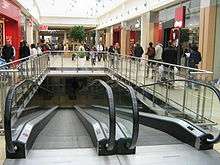
Third Polish Republic (1989 – present)
The collapse of the Soviet Union and the Revolutions of 1989 which saw also the collapse of the People's Republic of Poland made its impact on Bialystok. Following the liberalization of trade, The city became major transit and trade point for merchandise arriving from Belarus and Russia, and to support that, the City Market was established. The Communist party lost its monopoly over political life in the city and a process of decommunization began with changing names of streets and squares: Marcelego Nowotki changed in 1990 to Świętojańska, Lenina changed to Branickiego, Stalingradzka to Litewska, Swobodna to Dworska, Mikołaja Ostrowskiego to Grochowa, Mariana Buczka to Meksykańska, Stanisława Juchnickiego to Sukienna, Bronisława Wesołowskiego to Suraska[102] and Zygmunta Berlinga to Józefa Hallera.[103]
Pope John Paul II on 5 June 1991, during a visit to Bialystok, announced the decision to set up the Roman Catholic Archdiocese of Białystok.[104]
On 1 January 1999 Białystok was named the capital of the newly organized Podlaskie Voivodeship, which was created out of the former Białystok and Łomża Voivodeships and the eastern half of the former Suwałki Voivodeship, pursuant to the Polish local government reforms adopted in 1998.
Since the beginning of the century Białystok has significantly extended its area, incorporating neighboring villages such as Bialostoczek, Dziesieciny or Starosielce. The most recent incorporation, in 2006 were those of Zawady on the north and Dojlidy Gorne on the south. They have significantly increased the administrative area of the city to 102km2.
The accession of Poland to the EU in 2004 led to massive investments in the city, especially after the approval of Operational Program Development of Eastern Poland 2007–2013 as result of which the city saw modernization and completion of different projects: In 2008 'Alfa Centrum' was opened at the former site of Beckera Factory.[105] A new stadium was built Jagiellonia Białystok next to the City Market.
Białystok Subzone of the Suwałki Special Economic Zone was established in 2009 and covers an area of 30 ha. On October 2014, an application was forwarded to the management board of the SSEZ regarding the extension of the Białystok Subzone by more than 43 ha of land in Krywlany and almost 21 ha of plots of the Białystok Science and Technology Par which is which is located within the Dojlidy district, in the area of Borsucza, Żurawia and Myśliwska streets. It is located in the immediate vicinity developed and built-up real estate with a service function and the area of the Białystok SSZ Subzone.[106]
In 2015 the Municipal Waste Treatment Plant (Polish: Zakład Unieszkodliwiania Odpadów Komunalnych) in 40F Generała Władysława Andersa Street began operating, replacing the landfill in Hryniewicze.[107] In 2014 the municipal heating company (Polish: Miejskim Przedsiębiorstwie Energetyki Cieplnej w Białymstoku (MPEC)) was purchased by Enea Group. The company has also been a co-owner since 2008, and since 2011 the actual owner of the Białystok Heat and Power Plant, which already works in cogeneration. In 2019 an agreement between Enea Ciepło and the Polish Government to modernize 18km of pipelines as well as reconstruction of heating nodes. Individual nodes are constructed in order to reduce heat losses.[108] The connection of Białystok Power Station with the municipal MPEC network will allow the optimization of heat production in the city. The CHP plant has two modern biomass-fired units with zero CO2 emissions.[109] A major highway bypassing at the city edges, Generalska Route was built between 2009 and 2013 and Niepodległości Route (Polish: Trasa Niepodległości) was opened in 2019.
References
- "Miasta w Dokumencie Archiwalnym" (in Polish). Archived from the original on 26 October 2010. Retrieved 5 April 2011.
- Niewińska, Walentyna (1995). Legendy województwa białostockiego, łomżyńskiego, suwalskiego (in Polish). Białystok: Wojewódzka Biblioteka Publiczna im. Stefana Górnickiego w Białymstoku.
- "Czasy rodu Wiesiołowskich" (in Polish). Retrieved 17 May 2011.
- "Marszałkowie Sejmu" (in Polish). Retrieved 17 May 2011.
- Kądziela, Lukasz; Nagielski, Mirosław. Hetmani Rzeczypospolitej Obojga Narodów (in Polish). Warsaw: Bellona. ISBN 83-11-08275-8.
- Kowalski,Waldemar (1999). Stefan Czarniecki : żołnierz, obywatel, polityk (in Polish). Kielce: Kieleckie Towarzystwo Naukowe. ISBN 83-86006-28-5.
- "History of the City". Archived from the original on 15 August 2011. Retrieved 15 March 2011.
- Magdalena Grassmann. "Podlaski Wersal Branickich". palac.amb (in Polish). Archived from the original on 10 May 2009. Retrieved 18 September 2013.
- "Miasto Białystok". wrotapodlasia.pl (in Polish). Archived from the original on 11 April 2008. Retrieved 28 June 2008.
- Zimmerman, Joshua D. (2004). Poles, Jews, and the politics of nationality. Univ of Wisconsin Press. p. 16. ISBN 0-299-19464-7.
- "UWB Official website". Retrieved 7 June 2011.
- "Bialystok". Holocaust Encyclopedia. United States Holocaust Memorial Museum. Retrieved 26 July 2007.
- Mark, B (1952). Ruch oporu w getcie białostockim. Samoobrona-zagłada-powstanie (in Polish). Warsaw.
- Mark, B. (1952). Ruch oporu w getcie białostockim. Samoobrona-zagłada-powstanie (in Polish). Warsaw.
- Cegielski, Tadeusz; Łukasz Kądziela (1990). Rozbiory Polski 1772-1793-1795 (in Polish). Warsaw.
- The New annual register. 1808. p. 276 (footnotes).
- "Administrative division of Belarus: a historical information" (in Russian). Archived from the original on 26 October 2006. Retrieved 30 December 2009.
- War Land on the Eastern Front: Culture, National Identity, and German Occupation in World War I, Review author[s]: Peter Gatrell
- "Das Land Ober Ost" (in German). Retrieved 18 February 2011.
- Maly rocznik statystyczny, Warszawa 1939 (Concise Statistical Year-Book of Poland, Warsaw 1939) (in Polish)
- "Podział Polski między ZSRR i Trzecią Rzeszę według Paktu Ribbentrop-Mołotow" (in Polish). Retrieved 26 January 2011.
- "Mapa podziału Polski. Podpisy: Stalin, Ribbentrop" (in Polish). Retrieved 22 March 2011.
- Bydgoszcz 1939. Biuletyn IPN (in Polish). nr 35-36 (12/2003-1/2004 ed.). Warsaw: IPN. Archived from the original on 11 June 2011. Retrieved 18 September 2013.
1641-9561
- Gnatowski, M (1994). Białostockie Zgrupowanie Partyzanckie (in Polish). Białystok.
- "New Provinces of Poland (1998)". Archived from the original on 8 June 2011. Retrieved 28 March 2011.
- "Map of Poland". Retrieved 28 March 2011.
- Jankowiak, S. Trudny "powrót do macierzy" (in Polish). IPN.
- Dziennik Ustaw (in Polish). 1975. p. 91.
- "Museums (Podlaskie Museum)". visitbialystok.com. Retrieved 18 July 2011.
- "Białystok – Local history". Muzeum Historii Żydów Polskich. Archived from the original on 7 October 2011. Retrieved 18 July 2011.
- Archived 26 October 2010 at the Wayback Machine
- Historya Stefana na Czarncy Czanieckiego Wojewody kijowskiego hetmana polnego koronnego przez Ks. Michała Krajewskiego s.p.
- Hetmani Rzeczypospolitej Obojga Narodów, Warsaw, Bellona, 1994, ISBN 83-11-08275-8
- "Archived copy". Archived from the original on 15 August 2011. Retrieved 1 April 2011.CS1 maint: archived copy as title (link)
- Magdalena Grassmann. "Podlaski Wersal Branickich". palac.amb. Retrieved 28 June 2008.
- "Historia Białegostoku". bstok.pl (in Polish). Retrieved 31 October 2019.
- "Plejada gwiazd w nowym teatrze. Piotr Dąbrowski otwiera Komedialnię". Białystok Online (in Polish). Retrieved 31 October 2019.
- Jacek Kusznier, Elektrycy w historii Politechniki Białostockiej, "Maszyny Elektryczne – Zeszyty Problemowe", Nr 4/2018, p. 163-164 (in Polish)
- Joshua D. Zimmerman, Poles, Jews, and the politics of nationality, Univ of Wisconsin Press, 2004, ISBN 0-299-19464-7, Google Print, p.16
- Geifman 1993, p. 127
- Avrich 2006, p. 44
- An area of Russia where Jews were most oppressed, the Pale of Settlement gave rise to amazingly good things.
- Samuel Joseph, "Jewish immigration to the United States, from 1881 to 1910", Columbia University, 1914, pgs. 65–66,
- Simon Dubnow, Israel Friedlaender, "History of the Jews in Russia and Poland", Avotaynu Inc, 2000, pg 484,
- Sarah Abrevaya Stein, "Making Jews Modern", Indiana University Press, 2004, pg. 113
- Das Land Ober Ost (in German)
- 3rd Constituent Charter of the BNR Rada Archived 11 December 2015 at the Wayback Machine
- А. Сідарэвіч. Абвяшчэнне Беларускай Народнай Рэспублікі
- 100 rocznica odzyskania przez Białystok niepodległości
- "NIEPODLEGŁOŚĆ BIAŁYSTOK ODZYSKAŁ PÓŹNIEJ NIŻ RESZTA KRAJU. DLACZEGO? HISTORIA MIASTA 1914–1919". Bialystok Subiektywnie-Blog regionalno-turystyczny o Podlasiu i Podlaskiem. 9 November 2018. Retrieved 19 December 2019.
- "Unikatowe zdjęcie. Skład tymczasowego magistratu Białegostoku". Wyborcza. 9 February 2012. Retrieved 19 December 2019.
- "Wspólnie świętujmy wyzwolenie Białegostoku". Bialystok City Hall. 17 February 2017. Retrieved 19 December 2019.
- "Wyzwolenie Białegostoku. Pierwsza defilada od niepamiętnych czasów". Kurier Poranny. 19 February 2016. Retrieved 19 December 2019.
- Zbiór afiszów i druków ulotnych 1944–1950, nr z 376, sygn. 262 "Wystawa – 50 lat Archiwum w Białymstoku" Archived 22 July 2011 at the Wayback Machine,(in Polish) retrieved on: 9 August 2007.
- Evan Mawdsley, The Russian Civil War, Pegasus Books, 2007 ISBN 1-933648-15-5, Google Print, p.255
- Jewish Quarter of Bialystok in June, 1939
- Białystok lata 20, lata 30 – A. Dobroński, J. Szczygieł-Rogowska; Kreator Instytut Wydawniczy 2007
- Eduard Bernacki. Protection of the health of the inhabitants of Białystok in the first decade of the Second Polish Republic (in Białostocczyzna Nr 3/35/1994)
- J. Milewski, Białostocczyzna – początki niepodległości, p. 14-16
- J. Milewski, Białostocczyzna – początki niepodległości, p. 15-17
- Plan miasta Białegostoku (1938)
- Planty, czyli jak za dawnych lat – Kurier Poranny
- Białystok lata 20, lata 30 – A. Dobroński, J. Szczygieł-Rogowska; Kreator Instytut Wydawniczy 2007
- Yeshiva World News Staff (11 November 2009). "Levaya of Hagon Rav Dovid Kviat ZATZAL". Yeshiva World News. Retrieved 11 November 2009.
- Poranny Kurier. "Wysoki Stoczek. Reduta to pomnik chwały tych, którzy chcieli podjąć walkę, uratować honor miasta" (url) (in Polish). Retrieved 18 December 2019.
- Aleksander Dobroński. "Białystok we wrześniu 1939 roku" (url) (in Polish). Retrieved 17 March 2020.
- Aleksander Dobroński. "Białystok we wrześniu 1939 roku" (url) (in Polish). Retrieved 17 March 2020.
- Aleksander Dobroński. "Prof. Śleszyński: 1 września w Białymstoku panował rodzaj entuzjazmu, wiary i siły" (url) (in Polish). Retrieved 17 March 2020.
- obiezyswiat.org. "Podlaskie wędrówki – Białystok" (url) (in Polish). Retrieved 18 December 2019.
- Text of the Nazi–Soviet Non-Aggression Pact, executed 23 August 1939
- "Miejsca represji komunistycznych lat 1944–56". SLA Samy Zbrodny. Retrieved 8 September 2019.
- "Dawny budynek Izby Skarbowej". polskaniezwykla.pl. Retrieved 8 September 2019.
- "Sowieci zajęli Białystok w piątek. Pamiętny wrzesień 1939 (zdjęcia)". Kurier Poranny. 27 September 2016. Retrieved 8 September 2019.
- (in Belarusian)Уладзімір Снапкоўскі. Беларусь у геапалітыцы і дыпламатыі перыяду Другой Сусветнай вайны
- (in Belarusian) Сёньня – дзень ўзьяднаньня Заходняй і Усходняй Беларусі Archived 30 April 2014 at the Wayback Machine
- Michael Hope: Polish deportees in the Soviet Union Archived 16 February 2012 at the Wayback Machine
- Białystok w 80-leciu. W rocznicę odzyskania niepodległości 19 luty 1919-19 luty 1999, p. 51
- Doctor Marek Wierzbicki of Institute of National Remembrance. Review of a book anti-Soviet conspiracy along the Biebrza, X 1939 – VI 1941 by Tomasz Strzembosz
- "Investigation into the murders of several Poles in Białystok and its area in June 1941".
- Goldhagen, Daniel J. Hitler's Willing Executioners: Ordinary Germans and the Holocaust New York, NY: Vintage Books, 1997
- Sara Bender, The Jews of Byalistok, p. 93.
- "Kazimierz Krajewski, Shock in the Reich, Rzeczpospolita Daily". Archived from the original on 5 June 2011. Retrieved 2 February 2011.
- Zapomniana zbrodnia w Lesie Bacieczkowskim. 75 lat temu Niemcy zamordowali białostocką inteligencję
- "Białystok Offensive Operation". codenames.info. Retrieved 17 March 2020.
- Wodociągi i kanalizacja białegostoku od czasóW najdawniejszych do 2015 roku, p. 192
- Situational report of the head of intelligence at the AK District Command in Białystok – the city of "Wiktor" from 17 August, p. 28.
- Zajdler-Żarski, Resistance movement in 1939–1944 in Białostocczyzna, pp. 88–90.
- Wolna Praca : organ komitetów: Białostockiego Obwodowego i Miejskiego KP(b)B i Obwodowej Rady Delegatów Ludu Pracującego 1941.02.26 nr 24 (204).
- p. 130
- B. Fialkowska, Politics and Artists (1948–1959), Warsaw 1985, p. 101-103.
- Aleja Pochodów – reprezentacyjna arteria nowego, socjalistycznego miasta Białystok. „Architecturae et Artibus", Vol. 4, nr 3 (2012), pp. 41–42
- "Test Wiedzy o Historii Białegostoku. Lata 50. i 60. XX wieku". Kurier Poranny. 17 January 2017. Retrieved 10 December 2019.
- "Piaski: Była hala, jest ONZ. Historia centrum Białegostoku". Kurier Poranny. 11 May 2011. Retrieved 16 March 2020.
- "Historia Białegostoku". bstok.pl. Retrieved 28 March 2020.
- Encyclopedia of Solidarity, July 1981
- History of Solidarity, July–August 1981 Archived 23 July 2011 at the Wayback Machine
- Stan wojenny na Białostocczyźnie
- Akcja na "biały dom", czyli okupacja KW PZPR
- Dekomunizacja Białegostoku. Berlinga zmieniła się na Hallera. A Gorbatowa w Pankiewicza nie. 15 December 2016
- Archidiecezja Białostocka Archived 3 March 2011 at the Wayback Machine
- "Alfa – Centrum Mody i Rozrywki". Alfa Centrum. 9 February 2012. Retrieved 19 December 2019.
- Wschodzący Białystok
- Enea Ciepło zmodernizuje 18 km sieci w Białymstoku za 38,4 mln zł
- Enea Wytwarzanie właścicielem Elektrociepłowni Białystok i MPEC Białystok
Bibliography
- Geifman, Anna (1993). Thou Shalt Kill. Princeton: Princeton University Press. ISBN 0-691-02549-5.CS1 maint: ref=harv (link)
- Avrich, Paul (2006). The Russian Anarchists. Stirling: AK Press. ISBN 1-904859-48-8.CS1 maint: ref=harv (link)
- Davies, Norman (1972). White Eagle, Red Star: the Polish-Soviet War, 1919–20. New York: St. Martin's Press, inc. ISBN 0-7126-0694-7.CS1 maint: ref=harv (link)
- Przemysław Sieradzan (2005). "Julian Marchlewski i Krótka Historia PolRewKomu". Komunistyczna Partia Polski 1918–1938 (in Polish). Archived from the original on 9 August 2009. Retrieved 25 January 2007.
- Watt, Richard M. (1979). Bitter Glory: Poland & Its Fate 1918–1939. Simon & Schuster, NY. ISBN 0-7818-0673-9.
- Słownik Rozwoju Regionalnego. Warsaw: PARR. 2001.CS1 maint: ref=harv (link)
- "Polska Polsce nierówna" (in Polish). Archived from the original on 28 September 2011. Retrieved 4 June 2008.
- 'Polska A, B i C' (Poland A, B and C) (in Polish). Gazeta Wyborcza. 4 August 1999.CS1 maint: ref=harv (link)
- Glantz, David (2001). Barbarossa: Hitler's Invasion of Russia 1941. ISBN 0-7524-1979-X.CS1 maint: ref=harv (link)
- The initial period of war on the Eastern Front, 22 June–August 1941 : proceedings of the Fourth Art of War Symposium. FRG: Garmisch. October 1987. ISBN 0-7146-3375-5.CS1 maint: ref=harv (link)
- Janusz Żarnowski, "Społeczeństwo Drugiej Rzeczypospolitej 1918–1939" (in Polish language), Warszawa 1973
- Eugeniusz Mironowicz, "Białoruś" (in Polish language), Trio, Warszawa, 1999, ISBN 83-85660-82-8
Sources and external links
| Wikimedia Commons has media related to Białystok. |
- History of Bialystok
- Bialystoker Synagogue in New York City
- We Remember Jewish Bialystok!
- Historic images of Bialystok
- Jewish Heritage Trail in Bialystok
- Jewish Life in Bialystok, is a rare documentary, produced in 1939 by Shaul and Yitzhak Goskind of the Warsaw-based Sektor Films, into the people, communities and institutions of Białystok just prior to the start of World War II. Images of smokestacks, power looms, and textile workers; downtown shops and buses, market day with peasants and horses; schools, synagogues, the Sholem Aleichem Library, the TOZ sanatorium, and a community-run summer camp reflect the diversity of the city's 200-year-old Jewish community. In addition to the tile-roofed home of Dr. Zamenhof, creator of Esperanto, Jewish Life in Białystok features memorable images of a spacious park where young adults relax and children play.[1]
- w Białymstoku, a short 15-minute film from 1958 provides insights into life in the city during the middle of the last century. The filming was done by a team of cameramen (Kosińsiego, Krzyżańskiego, Jankowska and Szawłowskiego) with narration by Michael Radgowskiego.[2]
- 1 Maja w Białymstoku, a 14-minute film from 1961 provides a view into the activities surrounding International Workers' Day (May Day) events in the city during the early 1960s.[3]
- Documentary, an 11-minute film from 1972 provides insight into life in the city.[4]
